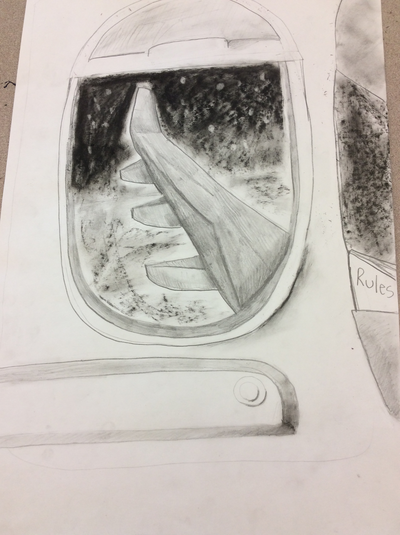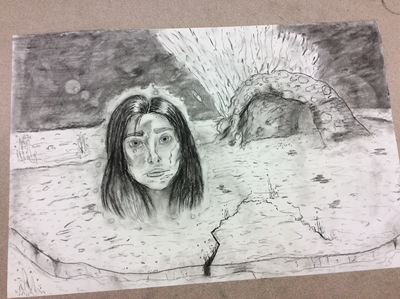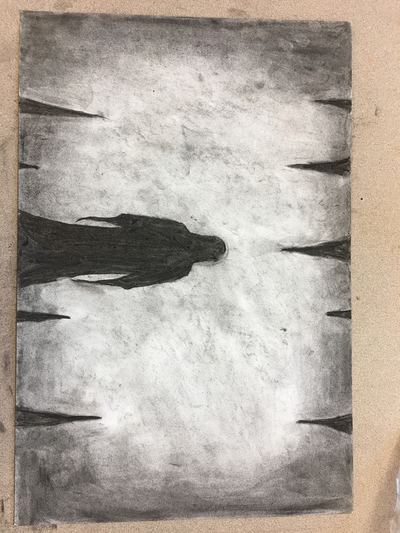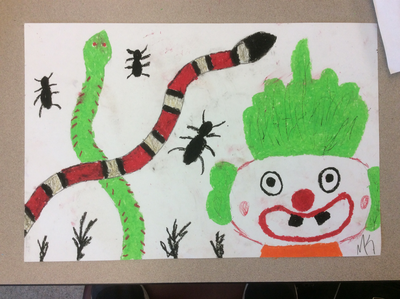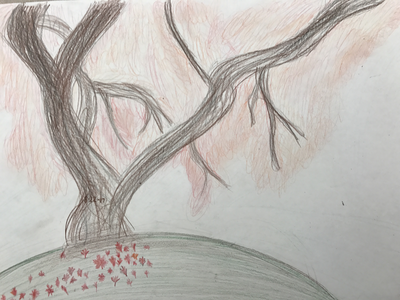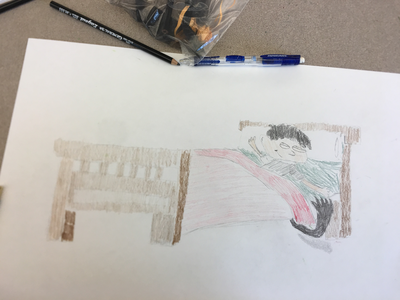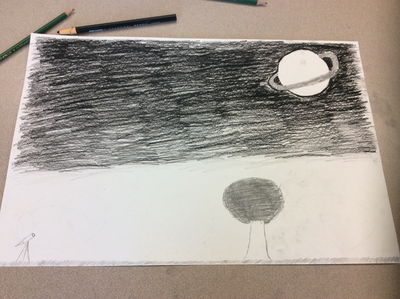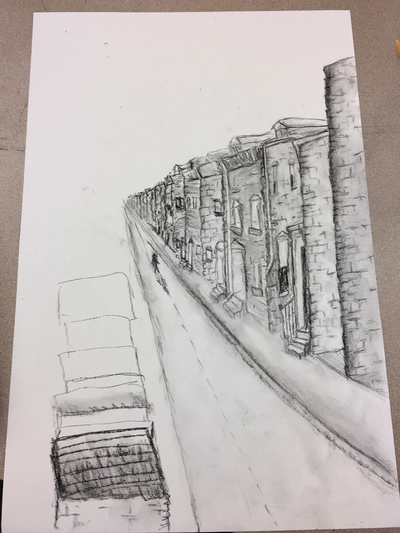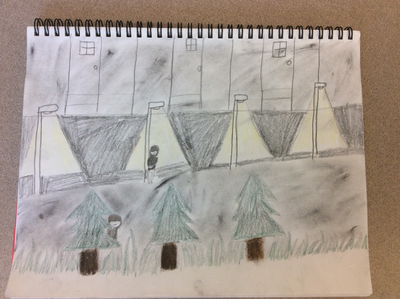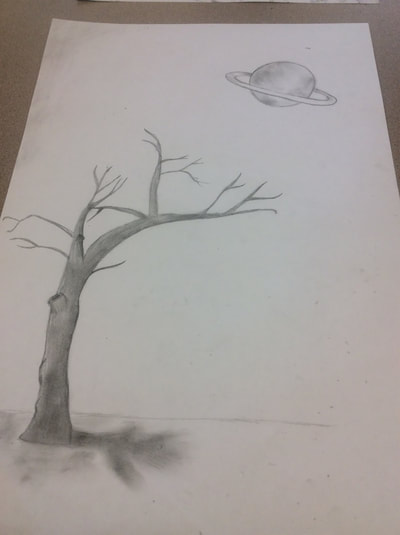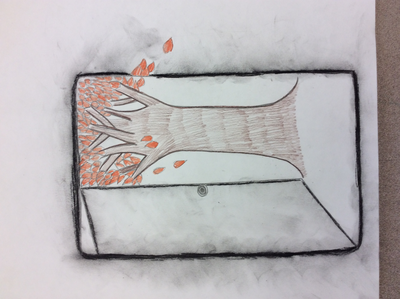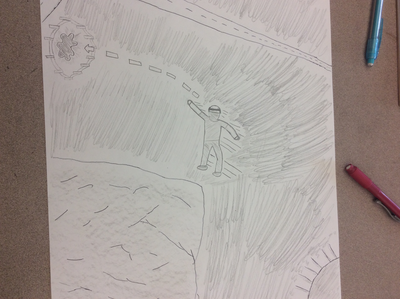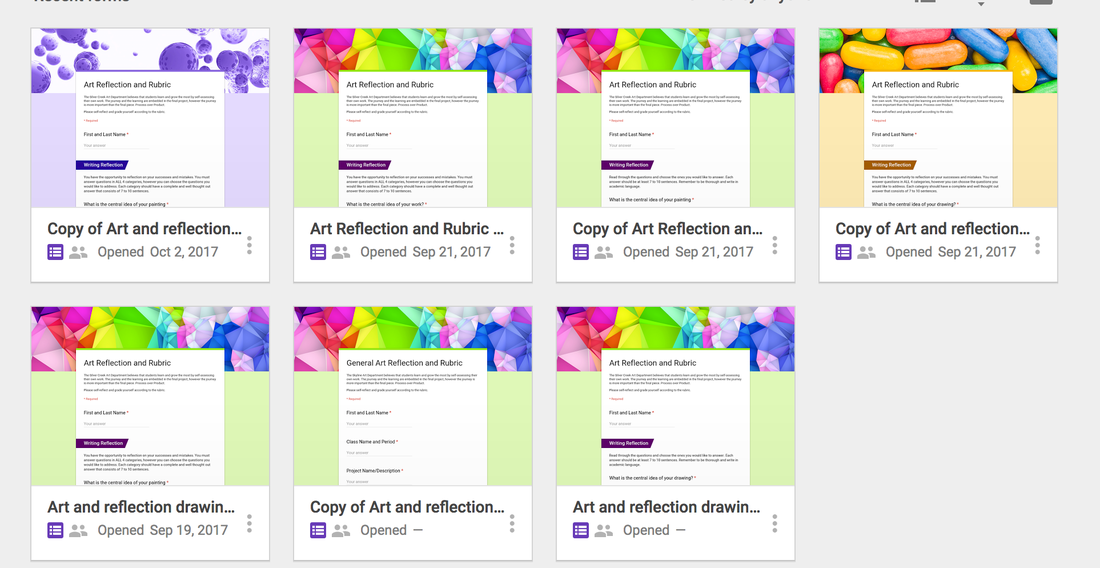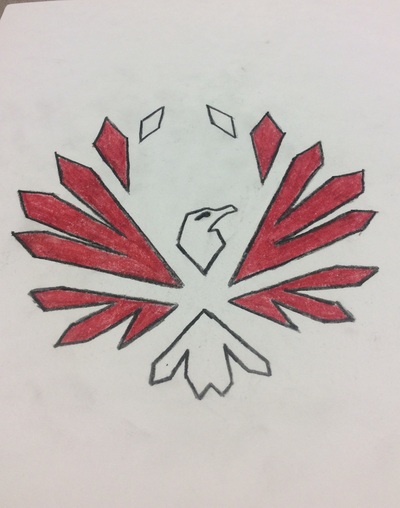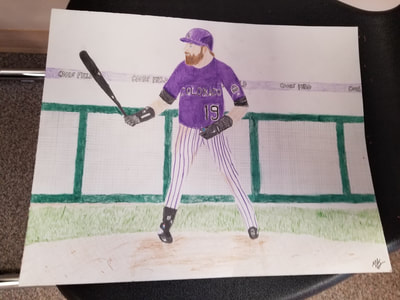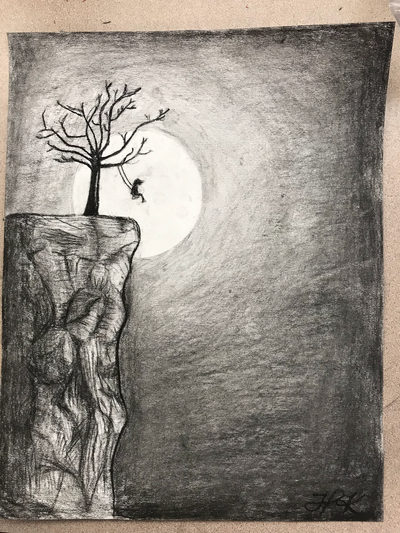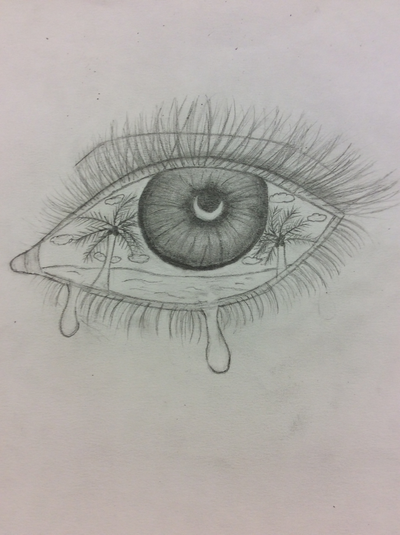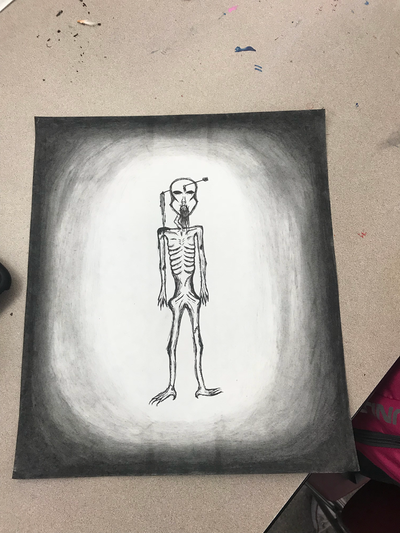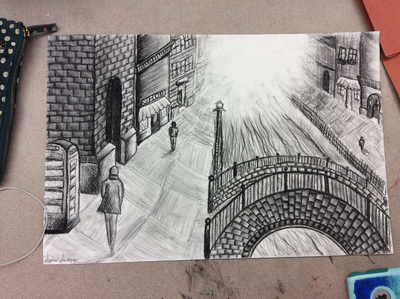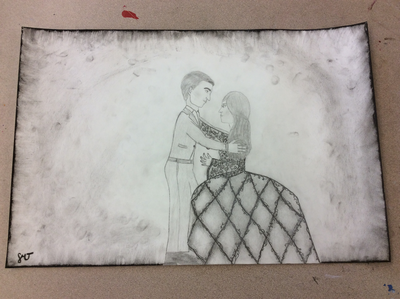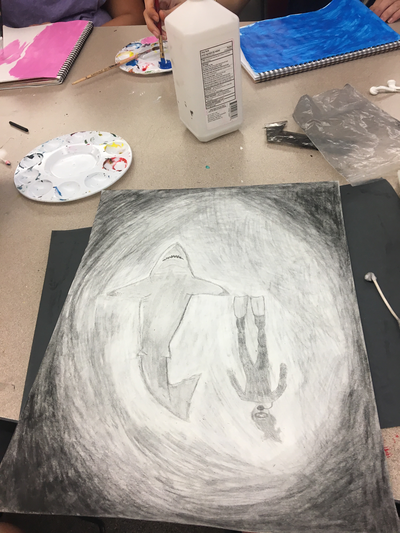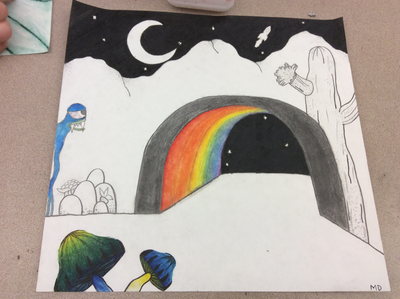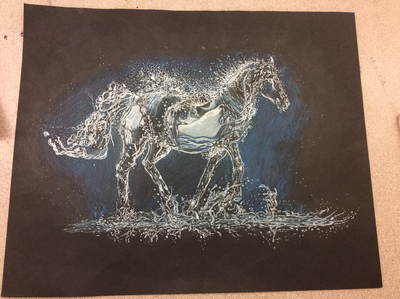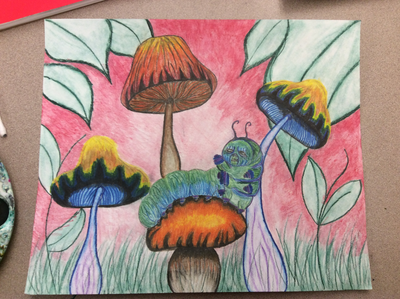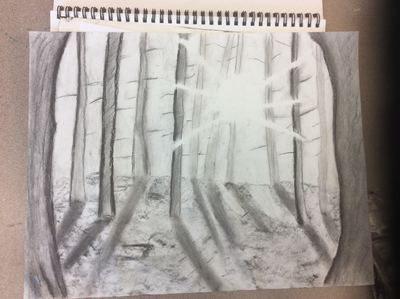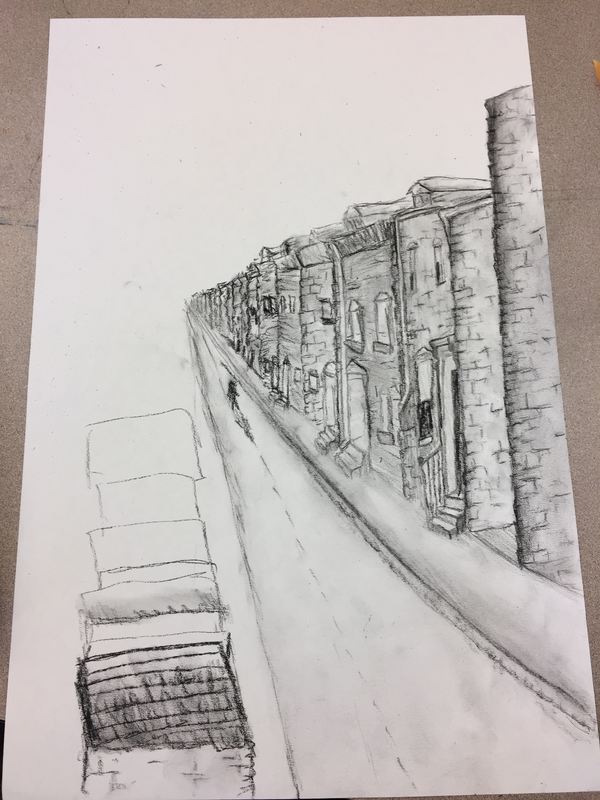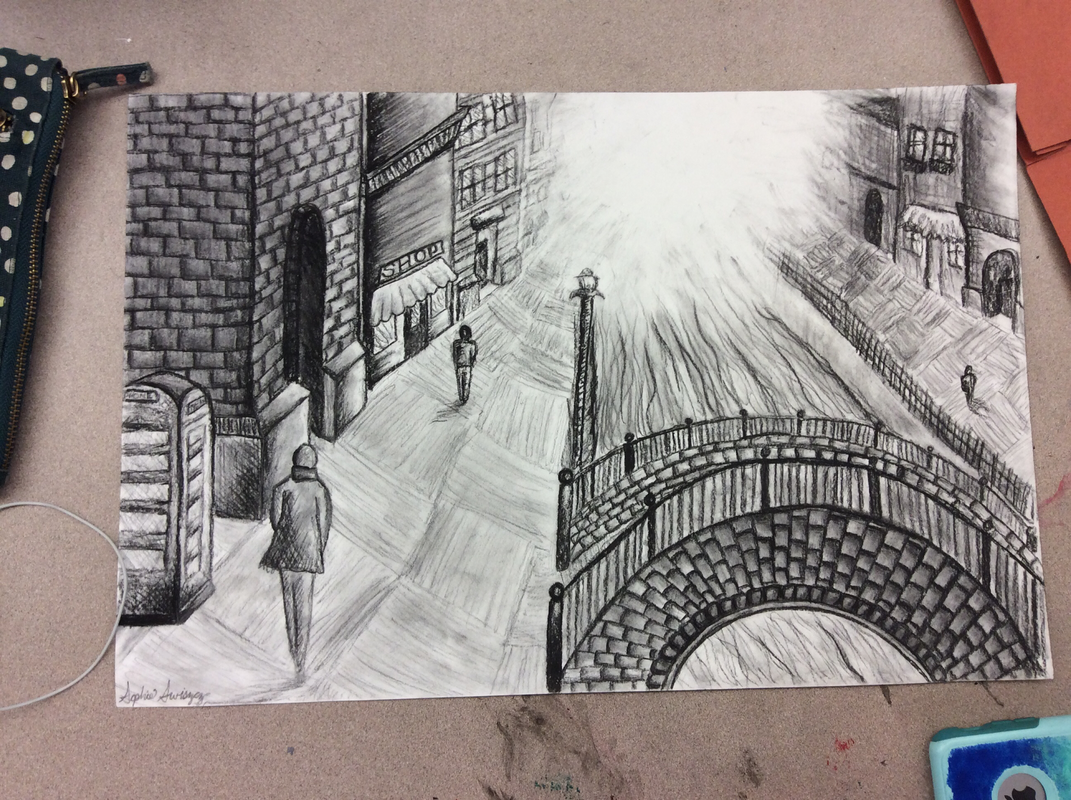Silver Creek Pre-assessment and Unit assessment (summative)
A pre-assessment was given as the learners began the semester. The materials (charcoal, colored pencil, pencil, oil pastels and ink) that would be covered in upcoming units were offered as part of the pre-assessment. Learners were asked to depict a dream or nightmare that they could remember, or what they thought a dream or nightmare might be. Seeing what material choices learners made was important in discovering which direction and order to lead explorations. Most learners were using materials that they were familiar with before this art class. Some learners had not taken an art class since elementary. This pre-assessment established a base line for improvement or further development of technique, material and craftsmanship.
Drawing Pre-assessment: Dreams and Nightmares
Assessment Process
Below you will find the reflection and rubric content of a form that we have the learners fill out upon completion of an assessment piece. These assessments are summative and come at the end of a unit of inquiry. Silver Creek art curriculum is modified choice. TAB (Teaching for Artistic Behavior) also known as choice classrooms have mostly been elementary and some middle school. It is not common for high school. Below you will notice the form mentioned above. It is typically placed on google classroom for the learners to access when they complete their assessment project and work at their own pace through the reflection. When issuing this reflection the learners are initially walked through the whole document to ensure maximum comprehension of expectations in writing and reflection. As it states below in the learner introduction to the form, Silver Creek art educators feel the process is often more important that the product. What did they learn along the way? What struggles did they overcome to get to their product? In what ways did they engage and persist throughout this assessment?
It was most difficult for learners to write about their work or their process. Some learners are asked to revisit their reflection for a chance of full points requested. While others write so much about their process and their experience and only request minimal passing grade. There are modality options for those who are not strong writers or have other difficulties with that form of expressing their knowledge. We encourage learners to show their learning through other venues, such as interviews, "ted talk" video presentation, or another form of communication.
During my time at Silver Creek High School my learners completed 7 assessments in four sections of art. Painting was the only group that completed one assessment, Though the painting class did engage in comprehensive learning activities that took much longer than one day.
This is what the learners see when they open their reflection. It is linked to google classroom so that they can access it through the class page. In practice we found that this reflection will usually take most of a class period to complete for most, learners at Silver Creek have i-pads that they access google classroom and other digital resources during the school day. Toward the end of my placement bluetooth keyboards were received in the art department to make typing easier on their i-pads.
Art Reflection and Rubric
The Silver Creek Art Department believes that students learn and grow the most by self-assessing their own work. The journey and the learning are embedded in the final project, however the journey is more important than the final piece. Process over Product. Please self-reflect and grade yourself according to the rubric.
* Required
First and Last Name *Writing Reflection read through the questions and choose the ones you would like to answer. Each answer should be at least 7 to 10 sentences. Remember to be thorough and write in academic language.
What is the central idea of your painting *
Techniques and Concepts: *
What technique did you use? Why? How well did you use/implement the technique you chose? What do you like about the technique? or What didn’t you like about the technique? Did you gain skills with this new technique? (Please use art vocabulary learned in class). What concepts or ideas did you use in your work? How did you incorporate the ideas/concepts into your work? What worked well for your concept/idea? or What didn’t work well? What was the intention of this artwork? Do you think it was successful in showing your idea?
Invention *
How did you use your own unique ideas in this artwork? What resources did you use? Did you copy directly or did you use a source for inspiration, then combine it with your own ideas to make it original? Did you try something that you weren’t sure about as part of this project? Did you pick a material or technique that was new or different over something that was familiar? How did you respond to challenges that occurred as you worked? Did your work take an unexpected turn due to a mistake or did something happen that was unplanned?
Craftsmanship *
Is your artwork neat and clean? Was your use of the media (materials) successful? Why or why not? Did you struggle with the media in control and adaptation? If you were to do this painting again would you approach it differently? In what way?
Effort *
How did you use the resources around you? (people, tutorials, problem solving) How did you handle or approach difficult roadblocks? How did you manage distractions? How did you use your class time? How did you demonstrate focus and commitment? Describe how you used persistence in this artwork
Art Rubric Please assign yourself a grade for each of the categories.
Technique/Art Concepts *
Mark only one oval.
Invention and Discovery *
Mark only one oval.
Craftsmanship *
Mark only one oval.
Effort *
Mark only one oval.
What grade do you think you deserve for this project? *
Please write your grade in Google Classroom comments.
Would you like Feedback on this assignment from Mrs. Hinds? *
Mark only one oval.
(If Yes) What specifically would you like feedback on?
Art Reflection and Rubric
The Silver Creek Art Department believes that students learn and grow the most by self-assessing their own work. The journey and the learning are embedded in the final project, however the journey is more important than the final piece. Process over Product. Please self-reflect and grade yourself according to the rubric.
* Required
First and Last Name *Writing Reflection read through the questions and choose the ones you would like to answer. Each answer should be at least 7 to 10 sentences. Remember to be thorough and write in academic language.
What is the central idea of your painting *
Techniques and Concepts: *
What technique did you use? Why? How well did you use/implement the technique you chose? What do you like about the technique? or What didn’t you like about the technique? Did you gain skills with this new technique? (Please use art vocabulary learned in class). What concepts or ideas did you use in your work? How did you incorporate the ideas/concepts into your work? What worked well for your concept/idea? or What didn’t work well? What was the intention of this artwork? Do you think it was successful in showing your idea?
Invention *
How did you use your own unique ideas in this artwork? What resources did you use? Did you copy directly or did you use a source for inspiration, then combine it with your own ideas to make it original? Did you try something that you weren’t sure about as part of this project? Did you pick a material or technique that was new or different over something that was familiar? How did you respond to challenges that occurred as you worked? Did your work take an unexpected turn due to a mistake or did something happen that was unplanned?
Craftsmanship *
Is your artwork neat and clean? Was your use of the media (materials) successful? Why or why not? Did you struggle with the media in control and adaptation? If you were to do this painting again would you approach it differently? In what way?
Effort *
How did you use the resources around you? (people, tutorials, problem solving) How did you handle or approach difficult roadblocks? How did you manage distractions? How did you use your class time? How did you demonstrate focus and commitment? Describe how you used persistence in this artwork
Art Rubric Please assign yourself a grade for each of the categories.
Technique/Art Concepts *
Mark only one oval.
- Advanced: Artwork shows a mastery of technique and reflects a deep understanding of concepts. (A)
- Proficient: Artwork shows good technique. The work reflects concepts discussed in class. (B)
- Basic: Artwork shows some technique and understanding of art concepts. (C)
- Beginning: Artwork shows limited technique and understanding of art concepts. (D)
Invention and Discovery *
Mark only one oval.
- Advanced: Student consistently displays willingness to try multiple solutions and ask thought provoking questions, which lead to deeper/more distinctive results. (A)
- Proficient: The student's exploration of multiple solutions and thinking like an artist develops and expands during the project.Art work reflects originality and expands on the original concept . (B)
- Basic: Student is developing an exploration of possible solutions and thinking like an artist. Artwork shows some evidence of originality and an attempt to expand on the original concept. . (C)
- Beginning: Student passively attempts to fulfill assignment without much thought or exploration of possibilities Art work shows little evidence of original thought, or expansion on the original concept. (D).
Craftsmanship *
Mark only one oval.
- Advanced: The artwork shows outstanding craftsmanship,with clear attention to control, adaptation, selection and experimentation of medium/media Art is in impeccable condition. (A).
- Proficient: The artwork shows good craftsmanship, with some attention to control, adaptation, selection and experimentation of medium/media. (B)
- Basic: The artwork shows average craftsmanship and average attention to control, adaptation, selection and experimentation of medium/media. (C)
- Beginning: The artwork shows limited craftsmanship and limited attention to control, adaptation, selection and experimentation of medium/media. (D)
Effort *
Mark only one oval.
- Advanced: Art work is completed with excellence and exceeded teacher expectations. Student exhibits focus, and clear commitment to the work. (A)
- Proficient: Art work is completed in an above average manner, yet more could have been done. Student needs to go one step further to achieve excellence. Time was well used. Project was finished on time. (B)
- Basic: Art work is complete but it lacks some finishing touches or can be improved with little effort. Class time was used adequately; however, more time on task would pay off. (C)
- Beginning:The student put forth little effort required to finish the project with detail and care; class time was not used well. Student goes through the motions, but isn’t always aware of the work. (D)
What grade do you think you deserve for this project? *
Please write your grade in Google Classroom comments.
Would you like Feedback on this assignment from Mrs. Hinds? *
Mark only one oval.
- Yes
- No
(If Yes) What specifically would you like feedback on?
Assessment Dreams and Nightmares: Final Products
Student Comparative Data
When looking at the before and after it is sometimes difficult to see where the growth lies. But when you lay them side by side and read what the learner has written about their process it is much clearer. Below are two examples.
Hattie:
What is the central idea of your painting *
The central idea of my painting is a nightmare in which a girl is swinging in front of the moon, over a very large drop. The idea was to create an image that gave you a more dark feeling when you look at it. It is pretty unrealistic that this image would ever be a reality, so you can think of it in many ways. It could be represented as someone who is simply afraid of heights, or you could say it represents someone who feels lost. The central idea, which was to create a nightmare image, has the ability to dive deeper into what the true meaning is.
Techniques and Concepts: *
What technique did you use? Why? How well did you use/implement the technique you chose? What do you like about the technique? or What didn’t you like about the technique? Did you gain skills with this new technique? (Please use art vocabulary learned in class). What concepts or ideas did you use in your work? How did you incorporate the ideas/concepts into your work? What worked well for your concept/idea? or What didn’t work well? What was the intention of this artwork? Do you think it was successful in showing your idea?
I used charcoal to create this image, however I first sketched it in my notebook. I practiced different techniques, such as just using pencil, adding colored pencil, but after testing charcoal I decided that would be the best option. I liked that it was fairly easy to blend, however it can be a bit messy which will sometimes make it difficult to keep your image looking neat.
Invention *
How did you use your own unique ideas in this artwork? What resources did you use? Did you copy directly or did you use a source for inspiration, then combine it with your own ideas to make it original? Did you try something that you weren’t sure about as part of this project? Did you pick a material or technique that was new or different over something that was familiar? How did you respond to challenges that occurred as you worked? Did your work take an unexpected turn due to a mistake or did something happen that was unplanned?
The first thing I had to decide was to have a dream theme, or a nightmare theme. I researched into both, and decided to go with nightmares. Mainly because I had done dreams for the pre- assessment, so I wanted to try something new. I used multiple sources for invention, however I mainly focused on one image. I typically don't use charcoal, because it is pretty messy. I wanted to try it for this, because it seemed like the most efficient and effective thing to use.
Craftsmanship *
Is your artwork neat and clean? Was your use of the media (materials) successful? Why or why not? Did you struggle with the media in control and adaptation? If you were to do this painting again would you approach it differently? In what way?
My artwork is fairly neat and clean; however, it is difficult to create a perfect image using charcoal. I struggled with getting fingerprints on the parts I wanted to be white, and then had trouble erasing them. On the other hand, I did enjoy using the charcoal and I found it fun to explore new techniques. If were to do this again I would plan out where to start to create the neatest image I could.
Effort *
How did you use the resources around you? (people, tutorials, problem solving) How did you handle or approach difficult roadblocks? How did you manage distractions? How did you use your class time? How did you demonstrate focus and commitment? Describe how you used persistence in this artwork
I think I used my class time wisely, because I was able to finish in the time given. I was focused and committed to the project, as I never got distracted or off task while working on it. I used resources such as various images from the internet, which helped me create my artwork.
Art Rubric
Please assign yourself a grade for each of the categories.
Technique/Art Concepts *
Proficient: Artwork shows good technique. The work reflects concepts discussed in class. (B)
Invention and Discovery *
Advanced: Student consistently displays willingness to try multiple solutions and ask thought provoking questions, which lead to deeper/more distinctive results. (A)
Craftsmanship *
Proficient: The artwork shows good craftsmanship, with some attention to control, adaptation, selection and experimentation of medium/media. (B)
Effort *
Proficient: Art work is completed in an above average manner; yet more could have been done. Student needs to go one step further to achieve excellence. Time was well used. Project was finished on time. (B)
What grade do you think you deserve for this project? *
Please write your grade in Google Classroom comments.
B+
Would you like Feedback on this assignment from Mrs. Hinds? *
No
What is the central idea of your painting *
The central idea of my painting is a nightmare in which a girl is swinging in front of the moon, over a very large drop. The idea was to create an image that gave you a more dark feeling when you look at it. It is pretty unrealistic that this image would ever be a reality, so you can think of it in many ways. It could be represented as someone who is simply afraid of heights, or you could say it represents someone who feels lost. The central idea, which was to create a nightmare image, has the ability to dive deeper into what the true meaning is.
Techniques and Concepts: *
What technique did you use? Why? How well did you use/implement the technique you chose? What do you like about the technique? or What didn’t you like about the technique? Did you gain skills with this new technique? (Please use art vocabulary learned in class). What concepts or ideas did you use in your work? How did you incorporate the ideas/concepts into your work? What worked well for your concept/idea? or What didn’t work well? What was the intention of this artwork? Do you think it was successful in showing your idea?
I used charcoal to create this image, however I first sketched it in my notebook. I practiced different techniques, such as just using pencil, adding colored pencil, but after testing charcoal I decided that would be the best option. I liked that it was fairly easy to blend, however it can be a bit messy which will sometimes make it difficult to keep your image looking neat.
Invention *
How did you use your own unique ideas in this artwork? What resources did you use? Did you copy directly or did you use a source for inspiration, then combine it with your own ideas to make it original? Did you try something that you weren’t sure about as part of this project? Did you pick a material or technique that was new or different over something that was familiar? How did you respond to challenges that occurred as you worked? Did your work take an unexpected turn due to a mistake or did something happen that was unplanned?
The first thing I had to decide was to have a dream theme, or a nightmare theme. I researched into both, and decided to go with nightmares. Mainly because I had done dreams for the pre- assessment, so I wanted to try something new. I used multiple sources for invention, however I mainly focused on one image. I typically don't use charcoal, because it is pretty messy. I wanted to try it for this, because it seemed like the most efficient and effective thing to use.
Craftsmanship *
Is your artwork neat and clean? Was your use of the media (materials) successful? Why or why not? Did you struggle with the media in control and adaptation? If you were to do this painting again would you approach it differently? In what way?
My artwork is fairly neat and clean; however, it is difficult to create a perfect image using charcoal. I struggled with getting fingerprints on the parts I wanted to be white, and then had trouble erasing them. On the other hand, I did enjoy using the charcoal and I found it fun to explore new techniques. If were to do this again I would plan out where to start to create the neatest image I could.
Effort *
How did you use the resources around you? (people, tutorials, problem solving) How did you handle or approach difficult roadblocks? How did you manage distractions? How did you use your class time? How did you demonstrate focus and commitment? Describe how you used persistence in this artwork
I think I used my class time wisely, because I was able to finish in the time given. I was focused and committed to the project, as I never got distracted or off task while working on it. I used resources such as various images from the internet, which helped me create my artwork.
Art Rubric
Please assign yourself a grade for each of the categories.
Technique/Art Concepts *
Proficient: Artwork shows good technique. The work reflects concepts discussed in class. (B)
Invention and Discovery *
Advanced: Student consistently displays willingness to try multiple solutions and ask thought provoking questions, which lead to deeper/more distinctive results. (A)
Craftsmanship *
Proficient: The artwork shows good craftsmanship, with some attention to control, adaptation, selection and experimentation of medium/media. (B)
Effort *
Proficient: Art work is completed in an above average manner; yet more could have been done. Student needs to go one step further to achieve excellence. Time was well used. Project was finished on time. (B)
What grade do you think you deserve for this project? *
Please write your grade in Google Classroom comments.
B+
Would you like Feedback on this assignment from Mrs. Hinds? *
No
Sophie:
What is the central idea of your painting *
The central idea of my piece most of my dreams can be very realistic but there is always the one part of the dream that is not. My piece is a drawing of a town with a river, with people walking around and a few shops. The town is realistic for the most part, but at the top there is a burst of light flooding the town with brightness. It is difficult to predict if the light is supposed to be there or if it is normal in that town however the people walking around don’t seem to notice the light. This piece shows how l like to dream about real places but add my own weirdness to the dream.
Techniques and Concepts: *
What technique did you use? Why? How well did you use/implement the technique you chose? What do you like about the technique? or What didn’t you like about the technique? Did you gain skills with this new technique? (Please use art vocabulary learned in class). What concepts or ideas did you use in your work? How did you incorporate the ideas/concepts into your work? What worked well for your concept/idea? or What didn’t work well? What was the intention of this artwork? Do you think it was successful in showing your idea?
I used charcoal, shading and crosshatch. I really enjoy using charcoal when shading because you can make so many different shades. I used shading because it is impossible for me as an artist to draw without shading. I also shading because I wanted to show shadow on the piece. I used crosshatch on the people’s clothing and on some of the buildings. I enjoy using crosshatch to show some pattern on the drawing. I think I used all of the techniques quite well. I like charcoal because you can rub it with your finger to make different shades. I liked crosshatch because it looked like fabric on the people’s clothing. I used the concept of perspective in my piece to make it look realistic. I also used the concept of shadow on the buildings. I used perspective by making a point and horizon line and then making the buildings in perspective. Finding a horizon line helped me with perspective. The intention was to just draw a town but as the piece progressed I wanted to add something so I added the light. I think I was successful showing my talent in this piece.
Invention *
How did you use your own unique ideas in this artwork? What resources did you use? Did you copy directly or did you use a source for inspiration, then combine it with your own ideas to make it original? Did you try something that you weren’t sure about as part of this project? Did you pick a material or technique that was new or different over something that was familiar? How did you respond to challenges that occurred as you worked? Did your work take an unexpected turn due to a mistake or did something happen that was unplanned?
I used my own ideas of what the shop fronts looked like. I looked at pictures of drawings of citizens and incorporated some of the buildings into my piece. I copied the first building on the left from a picture I saw and then combined my own ideas into the rest of the piece. I put a bridge in my piece that I was nervous to draw because I didn’t have anything to base it off of so I had to wing it. I used charcoal instead of pencil to practice using charcoal. My challenge was half way through the piece I realized I was drawing a difficult perspective point then I had originally intended. I responded by changing the perspective point.
Craftsmanship *
Is your artwork neat and clean? Was your use of the media (materials) successful? Why or why not? Did you struggle with the media in control and adaptation? If you were to do this painting again would you approach it differently? In what way?
My piece was not clear because I rubbed the charcoal all around the paper. I think my use of charcoal was very successful, I achieved what I wanted. Sometimes I struggled with the charcoal because it smeared to easily. I would approach it from a different perspective but I would draw it that same way.
Effort *
How did you use the resources around you? (people, tutorials, problem solving) How did you handle or approach difficult roadblocks? How did you manage distractions? How did you use your class time? How did you demonstrate focus and commitment? Describe how you used persistence in this artwork.
I asked Esther for her opinion on some of the things in the piece. I didn’t really have any roadblocks. I used my class time finding the pictures of the city and drawing the end of the piece. I showed commitment by working on it at home so I could finish it. I used persistence by drawing each individual brick in the buildings and the bridge. I became very tired of drawing bricks by the time I was finished.
Art Rubric
Please assign yourself a grade for each of the categories.
Technique/Art Concepts *
Advanced: Artwork shows a mastery of technique and reflects a deep understanding of concepts. (A)
Invention and Discovery *
Advanced: Student consistently displays willingness to try multiple solutions and ask thought provoking questions, which lead to deeper/more distinctive results. (A)
Craftsmanship *
Advanced: The artwork shows outstanding craftsmanship, with clear attention to control, adaptation, selection and experimentation of medium/media Art is in impeccable condition. (A).
Effort *
Advanced: Art work is completed with excellence and exceeded teacher expectations. Student exhibits focus, and clear commitment to the work. (A)
What grade do you think you deserve for this project? *
Please write your grade in Google Classroom comments.
A+
Would you like Feedback on this assignment from Mrs. Hinds? *
No
What is the central idea of your painting *
The central idea of my piece most of my dreams can be very realistic but there is always the one part of the dream that is not. My piece is a drawing of a town with a river, with people walking around and a few shops. The town is realistic for the most part, but at the top there is a burst of light flooding the town with brightness. It is difficult to predict if the light is supposed to be there or if it is normal in that town however the people walking around don’t seem to notice the light. This piece shows how l like to dream about real places but add my own weirdness to the dream.
Techniques and Concepts: *
What technique did you use? Why? How well did you use/implement the technique you chose? What do you like about the technique? or What didn’t you like about the technique? Did you gain skills with this new technique? (Please use art vocabulary learned in class). What concepts or ideas did you use in your work? How did you incorporate the ideas/concepts into your work? What worked well for your concept/idea? or What didn’t work well? What was the intention of this artwork? Do you think it was successful in showing your idea?
I used charcoal, shading and crosshatch. I really enjoy using charcoal when shading because you can make so many different shades. I used shading because it is impossible for me as an artist to draw without shading. I also shading because I wanted to show shadow on the piece. I used crosshatch on the people’s clothing and on some of the buildings. I enjoy using crosshatch to show some pattern on the drawing. I think I used all of the techniques quite well. I like charcoal because you can rub it with your finger to make different shades. I liked crosshatch because it looked like fabric on the people’s clothing. I used the concept of perspective in my piece to make it look realistic. I also used the concept of shadow on the buildings. I used perspective by making a point and horizon line and then making the buildings in perspective. Finding a horizon line helped me with perspective. The intention was to just draw a town but as the piece progressed I wanted to add something so I added the light. I think I was successful showing my talent in this piece.
Invention *
How did you use your own unique ideas in this artwork? What resources did you use? Did you copy directly or did you use a source for inspiration, then combine it with your own ideas to make it original? Did you try something that you weren’t sure about as part of this project? Did you pick a material or technique that was new or different over something that was familiar? How did you respond to challenges that occurred as you worked? Did your work take an unexpected turn due to a mistake or did something happen that was unplanned?
I used my own ideas of what the shop fronts looked like. I looked at pictures of drawings of citizens and incorporated some of the buildings into my piece. I copied the first building on the left from a picture I saw and then combined my own ideas into the rest of the piece. I put a bridge in my piece that I was nervous to draw because I didn’t have anything to base it off of so I had to wing it. I used charcoal instead of pencil to practice using charcoal. My challenge was half way through the piece I realized I was drawing a difficult perspective point then I had originally intended. I responded by changing the perspective point.
Craftsmanship *
Is your artwork neat and clean? Was your use of the media (materials) successful? Why or why not? Did you struggle with the media in control and adaptation? If you were to do this painting again would you approach it differently? In what way?
My piece was not clear because I rubbed the charcoal all around the paper. I think my use of charcoal was very successful, I achieved what I wanted. Sometimes I struggled with the charcoal because it smeared to easily. I would approach it from a different perspective but I would draw it that same way.
Effort *
How did you use the resources around you? (people, tutorials, problem solving) How did you handle or approach difficult roadblocks? How did you manage distractions? How did you use your class time? How did you demonstrate focus and commitment? Describe how you used persistence in this artwork.
I asked Esther for her opinion on some of the things in the piece. I didn’t really have any roadblocks. I used my class time finding the pictures of the city and drawing the end of the piece. I showed commitment by working on it at home so I could finish it. I used persistence by drawing each individual brick in the buildings and the bridge. I became very tired of drawing bricks by the time I was finished.
Art Rubric
Please assign yourself a grade for each of the categories.
Technique/Art Concepts *
Advanced: Artwork shows a mastery of technique and reflects a deep understanding of concepts. (A)
Invention and Discovery *
Advanced: Student consistently displays willingness to try multiple solutions and ask thought provoking questions, which lead to deeper/more distinctive results. (A)
Craftsmanship *
Advanced: The artwork shows outstanding craftsmanship, with clear attention to control, adaptation, selection and experimentation of medium/media Art is in impeccable condition. (A).
Effort *
Advanced: Art work is completed with excellence and exceeded teacher expectations. Student exhibits focus, and clear commitment to the work. (A)
What grade do you think you deserve for this project? *
Please write your grade in Google Classroom comments.
A+
Would you like Feedback on this assignment from Mrs. Hinds? *
No
Formative assessments
Formative assessments were daily, working individually with learners or in small groups. Periodically checking in with learners and making sure that each one was on the path they wanted to be on towards their learning. Learners are offered learning opportunities each day throughout a unit, they are assessed on their participation in the opportunity as well as formal assessments.
